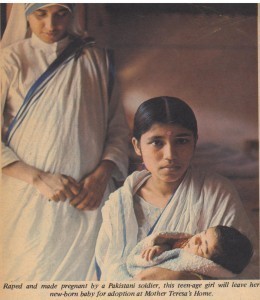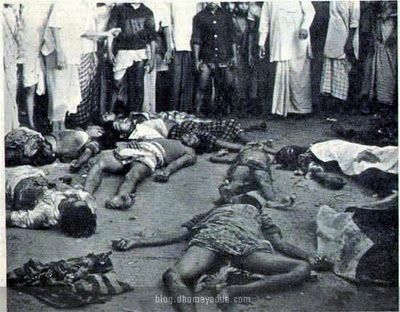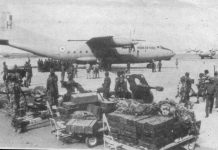During the 1971 Bangladesh war for independence, members of the Pakistani military and supporting Bihari and Razaker militias rap.ed between two and four hundred thousand Bangladeshi women in a systematic campaign of genocidal ra,pe .

Worth a Thousand Words: Bina D’Costa Tracked Down the Australian Doctor Who Performed Late-Term Abortions on 1971 Rape Survivors.
 My mother told me in 1971, you would send out the men in your family to look in large public parks for the bodies of loved ones who had “disappeared,” picked up by Pakistani soldiers. Despite the endless killings and torture, she still says, “There was a feeling in the air that you could do anything. Everyone knew Independence was only a matter of time.”But the one thing we did not hear about as much as we heard about the passionate fighting that defeated the Pakistani Army were the rap,es that took place in 1971. Many academics state that the first time ra,pe was consciously applied as a weapon of war was during the Bangladesh War of Independence.Yet growing up, those are the stories that were missing from the narrative the post-war generation were told. While the role of women as fighters and supporters of the war are highlighted, the stories of rap,e camps and war babies are largely ignored.
My mother told me in 1971, you would send out the men in your family to look in large public parks for the bodies of loved ones who had “disappeared,” picked up by Pakistani soldiers. Despite the endless killings and torture, she still says, “There was a feeling in the air that you could do anything. Everyone knew Independence was only a matter of time.”But the one thing we did not hear about as much as we heard about the passionate fighting that defeated the Pakistani Army were the rap,es that took place in 1971. Many academics state that the first time ra,pe was consciously applied as a weapon of war was during the Bangladesh War of Independence.Yet growing up, those are the stories that were missing from the narrative the post-war generation were told. While the role of women as fighters and supporters of the war are highlighted, the stories of rap,e camps and war babies are largely ignored. Each time I go home to Bangladesh, a relative, usually male, takes me aside and whispers stories to me about the “piles, and piles of bodies of rap.e victims” you would find under bridges in mass graves. “How many women were rap.ed and killed in the hands of Pakistani soldiers,” my uncle tells me as his voice whimpers. “You cannot imagine, Ma.”But a Bangladeshi scholar wants us to do just that. In fact, as a country we all owe a great deal to Bina D’Costa who went and tracked down the Australian doctor, Geoffrey Davis, brought to Dhaka by theInternational Planned Parenthood Federation (IPPF) and the United Nations. Davis was tasked with performing late-term abortions, and facilitating large scale international adoption of the war babies born to Bangladeshi women.D’Costa’s conversation with Dr. Davis was recently published in a Bangladeshi publication, and is worth reading in its entirety. The stories of women being tied to trees and gang rap.ed, breasts hacked off, dumped in mass graves, being held in Pakistani rap.e camps are all detailed.
Each time I go home to Bangladesh, a relative, usually male, takes me aside and whispers stories to me about the “piles, and piles of bodies of rap.e victims” you would find under bridges in mass graves. “How many women were rap.ed and killed in the hands of Pakistani soldiers,” my uncle tells me as his voice whimpers. “You cannot imagine, Ma.”But a Bangladeshi scholar wants us to do just that. In fact, as a country we all owe a great deal to Bina D’Costa who went and tracked down the Australian doctor, Geoffrey Davis, brought to Dhaka by theInternational Planned Parenthood Federation (IPPF) and the United Nations. Davis was tasked with performing late-term abortions, and facilitating large scale international adoption of the war babies born to Bangladeshi women.D’Costa’s conversation with Dr. Davis was recently published in a Bangladeshi publication, and is worth reading in its entirety. The stories of women being tied to trees and gang rap.ed, breasts hacked off, dumped in mass graves, being held in Pakistani rap.e camps are all detailed.
When asked if the usual figures of the number of women rap.ed by the Pakistani Army, 200-400,000, are accurate, Dr. Davis states that they are underestimated:
…Probably the numbers are very conservative compared with what they did. The descriptions of how they captured towns were very interesting. They’d keep the infantry back and put artillery ahead and they would shell the hospitals and schools. And that caused absolute chaos in the town. And then the infantry would go in and begin to segregate the women. Apart from little children, all those were sexually matured would be segregated..And then the women would be put in the compound under guard and made available to the troops…Some of the stories they told were appalling. Being rap.ed again and again and again. A lot of them died in those [rap.e] camps. There was an air of disbelief about the whole thing. Nobody could credit that it really happened! But the evidence clearly showed that it did happen.
Dr. Davis talks about how Sheikh Mujibur Rahman labeled the rap.e survivors as “war heroines” to help them reintegrate into their communities, but the gesture largely did not work. After being assaulted and impregnated by Pakistani soldiers, the Bangladeshi women were completely ostracized by society. Many were killed by their husbands, committed suicide, or murdered their half-Pakistani babies themselves. Some women were so scared to go back home after being held captive in Pakistani rap.e camps, they begged their Pakistani captors to take them back to Pakistan with them.
As I was reading through the article, I found myself simultaneously looking up sources online. Thisvideo of a NBC reporter who found a shelter where many women impregnated by Pakistani soldiers stayed until they delivered, makes you remember that when we talk about the large-scale violence against women that took place in 1971, often we are talking about young girls, sometimes just 13 years old.
As I struggled through my emotions to keep reading, I stopped and sat back in my chair. “What am I doing this for?” I asked myself. “What is the point of digging up all this horror?”































[…] Also see 1971 Mass Rap’e : Untold History of Bangladesh Liberation War. Wars like this always lead to further […]